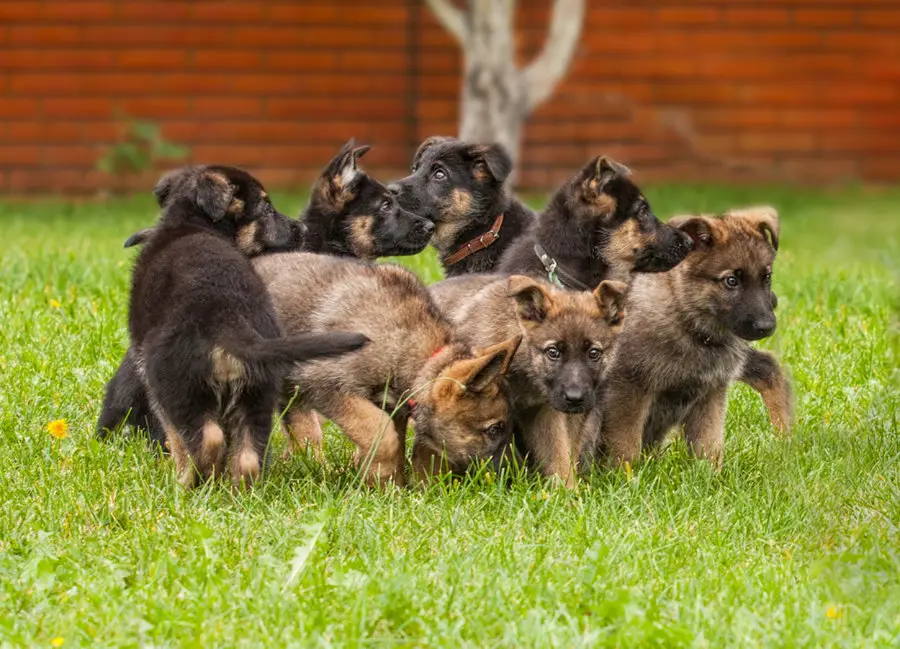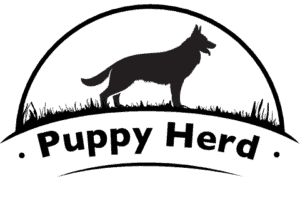German Shepherds Dogs appear naturally fierce, a trait that makes the breed excellent companions on a police force or military battalion. GSDs can also have bubbly and playful personalities behind closed doors that include cuddling and affection mouthing. But in scenarios where other breeds wag their tails vigorously, the German Shepherd seems to hang its tail low and steady.
German Shepherds do wag their tails, though far slower and less erratically than other breeds. The wag is most often a low swishing rather than a body-wiggling maneuver. Many German Shepherds reserve their intense tail-wagging for moments of pure joy, like greeting their favorite human at the door.
An enthusiastic German Shepherd with a vigorously wagging tail isn’t a sight you’ll see every day. However, there’s nothing physically wrong with a German Shepherd’s tail to stop it from wagging in the first place. To learn about why (or why not) a German Shepherd may wag its tail, read on.

How And Why German Shepherds Wag Their Tails
Huskies, Pitbulls, and Pugs are three entirely different dog breeds, but they all have one thing in common: Their natural tail positions. Whereas the German Shepherd holds its long, bushy tail in a near-permanent “down” position, these other breeds generally keep their tails curled upward — a look that appears friendlier and more inviting.
For the most part, the low-hanging tail of the German Shepherd means the dog is calm or tired. However, many people who misunderstand canine body language assume this steady or erect position is a sign of an aggressive or nervous dog. Or that German Shepherds don’t wag their tails at all.
Neither of these assumptions is true. Not only does the GSD wag its tail occasionally out of excitement, but the breed also wags its tail intentionally to express other emotions.
Left Or Right: Does It Matter?
As ridiculous as it might sound, dogs can communicate using their tails. So, it’s possible to figure out what your German Shepherd might be thinking by the directional sway of his tail wags. Wagging to the left is a sign of fear or nervousness, a response triggered by a sudden bang or a nearby growling dog. Right-wagging tails often stem from more positive emotions like excitement and curiosity, such as a spoon clanking on a metal dish.
Fast Or Slow?
By nature, German Shepherds aren’t an easily-excitable breed that’ll whip their tails to and fro for any old reason. A German Shepherd might swish his tail gently back and forth as he eagerly awaits the next round of fetch. A slow-wagging tail in German Shepherds can also be a sign of confusion or nervousness — like when a mysterious stranger comes near.
In rare circumstances, you might notice a bizarre sight: Your GSD rapidly wagging his tail back and forth like an excited Labrador! Wide tail wags are generally signs of genuine excitement, so your German Shepherd will reserve these displays for his favorite people, places, and things. For example, a German Shepherd may only wag his tail when his owner walks through the front door after being gone for eight hours or when you unpack a brand new tennis ball.
Additionally, a rapid, stiff tail wag is usually a sign of aggression or agitation in GSDs. Keep your distance from a German Shepherd wagging its tail in this manner, as it might be fearful or suspicious enough to lunge or bite a stranger.
If you want to learn more about how dogs use their tails to convey what they’re thinking and feeling? The video below will review the basics of tail communication in canines:
Other Ways A German Shepherd Communicates
German Shepherds may not have the most expressive tails in the canine world. Yet, the breed does express positive emotions in other ways. If you usually rely on a dog’s tail to determine when it’s happy, you can tell how your German Shepherd is feeling through:
- Physical Affection: Shepherds may weigh 50-90 pounds (23-41 kg) and are far from “lap dogs,” but that doesn’t mean they won’t join you in bed or on the couch for a cuddle session.
- Eye Contact: Nothing will make a German Shepherd happier than locking its beady, brown eyes with its favorite human. Direct contact and a peaceful gaze are signs of love.
- Physical Proximity: German Shepherds love to venture off on their own, but a loyal German Shepherd will also follow its favorite human around wherever they may go.
- Touch: Normally, you’re the one petting your GSD. But this breed is also known for offering gentle nudges, boops, and face licks to express happiness and true joy.
A German Shepherd who doesn’t wag its tail or only occasionally swishes it side-to-side isn’t necessarily unhappy or frustrated. It’s far easier to determine a GSD’s emotional state by observing its other behaviors instead.
Why German Shepherds May Not Wag Their Tails
The lack of (or bizarre) tail wags is one of the biggest mysteries to new German Shepherd owners. They might assume that their new puppy merely doesn’t like them and is struggling to bond. Or they take their puppy to the vet to see if there’s a medical problem causing this presumed lack of excitement. But there are a few simple explanations for why German Shepherds only wag their tails modestly (or not at all):
It Takes Time
German Shepherds are among the least trusting dog breeds in the world. As a GSD hits the 8, 10, or 12-month marks, it begins to understand the difference between strangers and “family.” Once your German Shepherd understands that you’re a member of his pack and his primary source of food and comfort, he’ll feel more comfortable around you. Many GSD owners report not seeing their puppy wag its tail until well past the six-month mark, and often do it out of the blue.
It Comes Down To Personality
A dog’s breed might make it more prone to giving chase to small rodents or becoming protective of its “pack.” However, all dogs — including German Shepherds — have unique personalities separate from the breed or genetic factors. While some GSDs knock their tails against door frames and tables, others never develop the tail-wagging instinct. Some Shepherds don’t wag their tails at all until they’re excited. Triggers include seeing a friend for the first time in months.

It Requires Genuine Excitement
Many highly excitable dog breeds, like Retrievers and Collies, will wag their tails for anything and everything. For some easily excitable dog breeds, dinner time, an impromptu play session, and grabbing the leash may be all it takes to catch a vigorous wag and excited bark.
But German Shepherds are a little more particular about where they use their energy. Just look at how large and bulky your Shepherd’s tail looks compared to smaller and thinner dogs. Anything more than a slow swish requires a great deal of effort and must be “worth it” in the eyes of your puppy. So, your GSD’s rare tail wag is more likely to stem from an unexpected visit from a trusted family friend or a surprise visit to the dog park.
Final Thoughts
While stereotypical tail wagging is more of an oddity in German Shepherds, a lack of wagging isn’t a sign that your dog dislikes you or is injured. It’s not in a GSD’s nature to wag its tail as excitedly and vigorously as other breeds. However, it’s essential to keep a close eye on your German Shepherd’s tail in another way. This loyal dog breed has an unfortunate reputation of suffering from limber tail syndrome or tail infections, which may require medical treatment.
